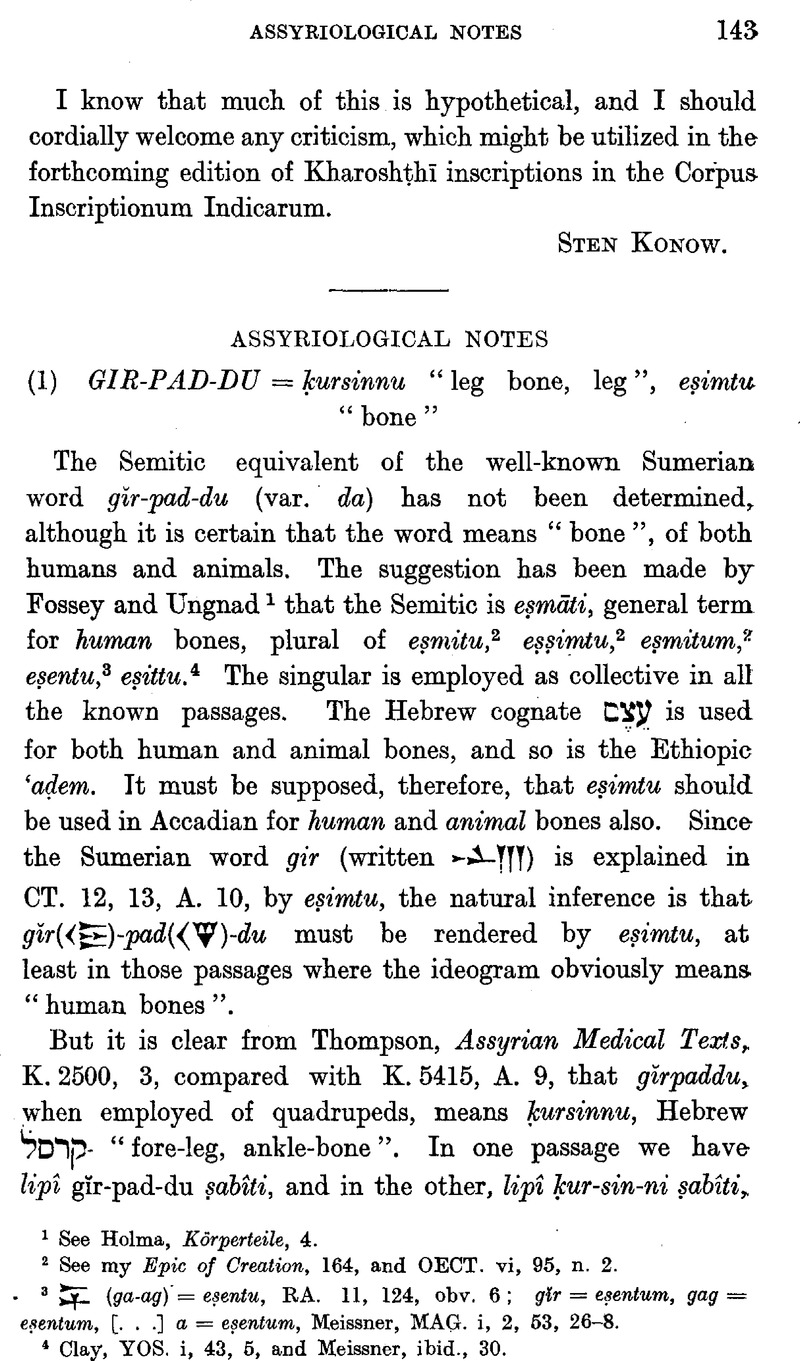No CrossRef data available.
Article contents
Abstract

- Type
- Miscellaneous Communications
- Information
- Copyright
- Copyright © The Royal Asiatic Society 1928
References
page 143 note 1 See Holma, , Körperteile, 4Google Scholar.
page 143 note 2 See my Epic of Creation, 164, and OECT. vi, 95, n. 2.
page 143 note 3 ![]() (ga-ag) = eṣentu, RA. 11, 124, obv. 6; gῐr = eṣentum, gag = eṣentum, […] a = eṣentum, Meissner, , MAG. i, 2, 53, 26–8Google Scholar.
(ga-ag) = eṣentu, RA. 11, 124, obv. 6; gῐr = eṣentum, gag = eṣentum, […] a = eṣentum, Meissner, , MAG. i, 2, 53, 26–8Google Scholar.
page 143 note 4 Clay, , YOS. i, 43Google Scholar, 5, and Meissner, ibid., 30.
page 144 note 1 Proceedings of the Royal Society of Medicine, xix, 48.
page 144 note 2 Babyloniaca, iii, 298, 2 (his days will be shortened), gūd, but 1. 5, gid, (they will be long); Virolleaud, , Astrologie, Sin iv, 19–20Google Scholar, the night is arilc (ik), but in the opposite omen gūd-da (kurû).
page 145 note 1 The root gud, “to cut off, shorten,” was entered in my Vocabulary, Sumerian Grammar, but not by Delitzsch in his Glossar.
page 145 note 2 Spelledk|ḳur-sin-nu, k|ḳur-si-nu.
page 145 note 3 The diminutive ending al in Semitic languages is regarded as Indo-Germanic by Brockelmann, , Vergleichende Grammatik, i, 402Google Scholar. But this cannot be assumed for Assyrian words, like ḳâḳullu, Arabic ḳauḳal “partridge”, diminutive of ḳâḳû, or nappillum “a garment”, diminutive of nappû.
page 146 note 1 Also bê, bu = zû, Clay, , YOS. i, 53, 129Google Scholar, where var. CT. 35, 3, 29,. has KU(bi-e) = tezû; KU(bu) = zû, RA. xi, 121, iv, 6.
page 146 note 2 Or read simply á-mušen = kappu. Falsely transcribed by Küchler., 24, 35.
page 147 note 1 Ebeling, , Archiv für Geschichte der Medizin, xiii, 11, n. 3Google Scholar, correctly read these passages and DrThompson, R. C., Proceedings of the Royal Society of Medicine, xix, 61, n. 5Google Scholar, proved it by the variant [ina] ga-pi tušapra-šu. See also Ebeling, , Keilinschriften aus Assur, 17Google Scholar, obv. 5, á-bi = kappa-ša, and Geller, in Meissner's, Altorientalische Texte und Untersuchen, i, 283Google Scholar, Tafel iii, 5. á-sud = kappu, K.Bö. i, 42, i, 34; á-mušen-na = kappu, iv, R. 21, B. 10; á-(sir-ra) = kappu, RA. 13, 186, 43.
page 147 note 2 Note 5 in PRSM., ibid.
page 147 note 3 Cf. Thompson, , PRSM. xvii, 21, 10Google Scholar; AMT. 6, 9, 10–11; iv, R. 29*, C. i, 9, etc., here = Sum. bar-gul.
page 148 note 1 Thompson, , PRSM. xix, 61, n. 5Google Scholar, suggested ![]() “to throw”. Professor Margoliouth, who made a thorough investigation of the Arabic verb
“to throw”. Professor Margoliouth, who made a thorough investigation of the Arabic verb ![]() for me, also thinks that, if a Babylonian verb warû (= vomere) exists, it may be
for me, also thinks that, if a Babylonian verb warû (= vomere) exists, it may be ![]() “to throw”. Against this derivation are: (1) the definite statement in the syllabary, HAL (buru) = arû, and buru in Sumerian most probably means “glow, be hot”, and no Sumerian word bur, buru for “throw” exists; (2) no Semitic language has a verb for “throw”, which was consequently employed for vomere. Professor Margoliouth, however, claims that Arabic
“to throw”. Against this derivation are: (1) the definite statement in the syllabary, HAL (buru) = arû, and buru in Sumerian most probably means “glow, be hot”, and no Sumerian word bur, buru for “throw” exists; (2) no Semitic language has a verb for “throw”, which was consequently employed for vomere. Professor Margoliouth, however, claims that Arabic ![]() “to emit fire” is identical with
“to emit fire” is identical with ![]() “to throw”. It is certain that in the passage ŝammaḫu ŝa ina unṣi it-tarru-ú “the great intestine which by hunger is consumed”, the verb is actually employed in a sense identical with the Arabic
“to throw”. It is certain that in the passage ŝammaḫu ŝa ina unṣi it-tarru-ú “the great intestine which by hunger is consumed”, the verb is actually employed in a sense identical with the Arabic ![]() “to be consumed by an internal ulcer”. My rendering in Babylonian Wisdom, 58A. should be corrected.
“to be consumed by an internal ulcer”. My rendering in Babylonian Wisdom, 58A. should be corrected.


